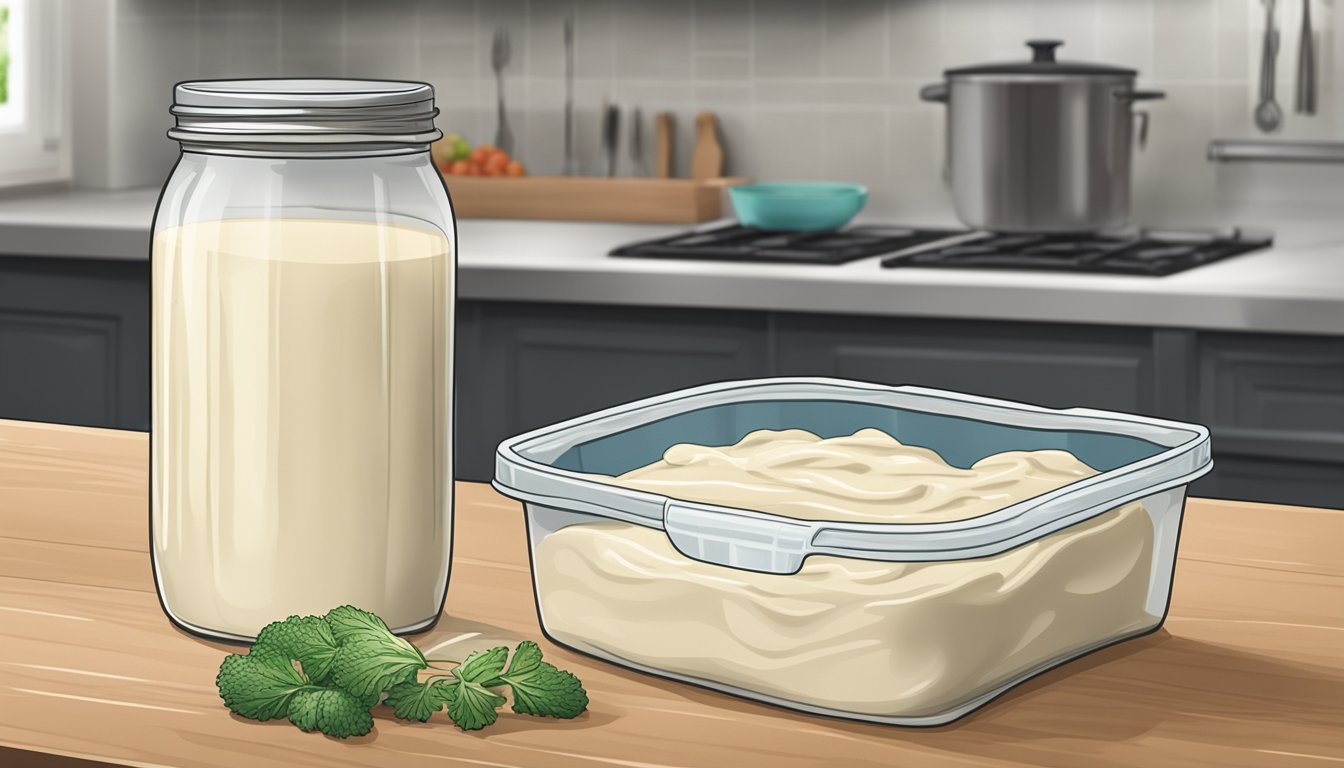Alfredo sauce, with its creamy and indulgent flavor, has the power to elevate any pasta dish to a new level of deliciousness.
But what if you find yourself with an abundance of this delectable sauce and no immediate plans to use it?
Can you freeze alfredo sauce?
The answer may surprise you.
While freezing may alter its texture, causing some separation, rest assured that with proper steps and precautions, you can preserve the essence of this creamy delight for future culinary adventures.
Stay tuned to unravel the secrets of freezing alfredo sauce and discover the versatility it offers beyond the traditional pasta dish.
can you freeze alfredo sauce
Yes, you can freeze alfredo sauce.
However, freezing may cause changes in texture and separation of water and fat.
The sauce may turn yellowish when frozen, but this is normal.
It is best to freeze the sauce on the day it’s made, allowing it to cool to room temperature first.
Transfer it to a freezer-safe bag or container, removing as much air as possible, and label and date it.
The sauce should be used within 3 months.
Thaw it in the refrigerator overnight and reheat properly using either the stove or microwave.
Key Points:
- Freezing alfredo sauce is possible.
- Freezing may affect texture and cause separation.
- The sauce may change color when frozen but this is normal.
- Freeze the sauce on the day it’s made after cooling to room temperature.
- Store in a freezer-safe bag or container, removing air and labeling.
- Use the sauce within 3 months and thaw in the refrigerator before reheating.
can you freeze alfredo sauce – Watch Video
💡
Pro Tips:
1. Alfredo sauce can be frozen, but it may alter the texture. The sauce might separate when thawed, but you can easily fix it by stirring it vigorously or blending it.
2. Traditional Alfredo sauce consists only of butter, Parmesan cheese, and pasta water. Unlike the heavy cream-based versions, it is a lighter and more authentic option.
3. The popular pasta dish Fettuccine Alfredo was created in Rome by Alfredo di Lelio in the early 20th century. He invented the dish as a way to soothe his pregnant wife’s morning sickness.
4. Fettuccine Alfredo became popularized in the United States after Hollywood stars Mary Pickford and Douglas Fairbanks fell in love with the dish during their honeymoon in Rome and spread its fame when they returned to the US.
5. In Italy, Alfredo sauce is often not used on pasta but rather as a base for other traditional dishes, such as gnocchi or polenta.
1. Freezing Alfredo Sauce Without Compromising Texture And Quality
Freezing Alfredo sauce is a convenient way to preserve this creamy and flavorful sauce for later use. However, it’s important to note that freezing may change the texture of the sauce, and the water and fat may separate upon thawing. Despite these potential changes, there are steps you can take to minimize these effects and ensure that the frozen Alfredo sauce remains delicious.
When freezing Alfredo sauce, it’s recommended to:
- Use a high-quality, airtight freezer-safe bag or container to prevent freezer burn and the absorption of unwanted odors.
- Freeze the sauce on the same day it’s made to preserve its flavor and quality. Freshly made sauce tends to freeze better compared to sauce that has been refrigerated for a few days.
Note: Freezing Alfredo sauce can alter its texture and cause separation of water and fat upon thawing. Therefore, proper storage and freshness are essential for maintaining the sauce’s taste and quality.
2. Normal Color Change When Freezing Alfredo Sauce
Don’t be alarmed if you notice that your Alfredo sauce has turned slightly yellowish after freezing, as this is a normal occurrence and not a sign of spoilage. The fats in the sauce can undergo some changes during the freezing process, causing a slight change in color. However, the taste and quality of the sauce should not be affected by this color change.
It’s important to keep in mind that while the color change is normal, ensure that the sauce smells and tastes fine before using it. If you notice any off-putting odors or flavors, it’s best to discard the sauce to avoid any potential health risks.
– Color change is normal, not a sign of spoilage
– Freezing can cause fats in the sauce to change color
– Taste and quality of the sauce should not be affected
– Check for any off-putting odors or flavors before using
– Discard if sauce smells or tastes off to avoid health risks.
3. Freezing Alfredo Sauce On The Same Day For Better Results
To ensure the best flavor and quality of Alfredo sauce, it is recommended to freeze it on the same day of preparation. Delaying the freezing process may result in a loss of taste and texture. By freezing the sauce promptly, you can maintain its original flavors and prevent the growth of bacteria that can lead to spoilage.
When freezing a large quantity of Alfredo sauce, it is advisable to divide it into smaller portions. This approach allows for easier thawing and the utilization of only the necessary amount, minimizing wastage.
- Freeze Alfredo sauce on the same day it’s made
- Freezing maintains flavor and texture
- Dividing into smaller portions aids in thawing and reduces wastage
4. Cooling The Sauce Before Freezing
Before transferring the Alfredo sauce to a freezer-safe bag or container, ensure that it has cooled to room temperature to avoid condensation and moisture accumulation. This step is crucial as warm or hot sauce can cause the freezer to work harder to cool down, leading to potential moisture buildup and affecting the texture of the sauce.
Allowing the sauce to cool naturally before freezing also helps to maintain its creaminess and prevents the separation of fats and water during the freezing process.
5. Properly Sealing And Labeling The Frozen Alfredo Sauce
To prevent freezer burn and maintain the quality of the Alfredo sauce, it’s vital to properly seal it before freezing. Remove as much air as possible from the freezer-safe bag or container and ensure a tight seal to prevent moisture from entering and affecting the sauce’s texture.
To avoid confusion and ensure efficient organization, label and date the frozen Alfredo sauce. This way, you can easily identify the sauce when retrieving it from the freezer and keep track of its consumption timeline.
6. Best Consumption Timeline For Frozen Alfredo Sauce
While frozen Alfredo sauce can be stored for an extended period, it’s recommended to use it within three months for the best results. Generally, the longer the sauce is stored in the freezer, the more likely it is to undergo changes in texture and overall quality.
To ensure optimal taste and texture, it’s best to consume the frozen Alfredo sauce as soon as possible. This ensures that you can enjoy the sauce at its peak quality and minimize the risk of any potential negative changes.
7. Dividing The Sauce For Easier Thawing And Portion Control
To enhance the thawing process and ensure better portion control, dividing the Alfredo sauce into individual servings before freezing is highly recommended. This approach allows for thawing and using only what is needed, minimizing waste and preserving the rest of the sauce in its frozen state.
Freezing the sauce in individual portions offers the convenience of easily thawing and utilizing it without the need to defrost the entire batch each time. As a result, meal preparation becomes quicker and more efficient.
In summary, here are the benefits of portioning Alfredo sauce before freezing:
- Easier thawing process
- Better portion control
- Reduced waste
- Preserved quality of remaining sauce
Tip: By dividing the sauce into individual containers or freezer bags, you can store them in an organized manner and stack them efficiently in your freezer.
8. Labeling And Dating Containers For Easy Identification
Properly labeling and dating the containers storing the frozen Alfredo sauce is crucial for easy identification. Clear and concise labels ensure that you can easily distinguish the sauce from other frozen items in your freezer. Additionally, including the date of freezing helps you keep track of its storage duration and determine whether it’s still within the recommended consumption timeframe.
A simple marker or adhesive label on the containers can save you time and prevent any confusion when locating and using the sauce.
- Properly label and date the containers to distinguish the Alfredo sauce.
- Clear and concise labels ensure easy identification in the freezer.
- Include the date of freezing to track storage duration.
- Use a marker or adhesive label for convenience and clarity.
9. Reheating Tips For Frozen Alfredo Sauce With Dairy
Alfredo sauce, particularly those made with dairy ingredients, may naturally split after being frozen and thawed. To restore the creamy consistency, it’s essential to reheat the sauce properly.
Here are some tips to reheat frozen Alfredo sauce and maintain its delicious texture:
-
Thaw the frozen Alfredo sauce in the refrigerator overnight to ensure a gradual thawing process. Avoid thawing the sauce at room temperature, as this can lead to inconsistent thawing and the potential for bacteria to multiply in the warmer areas of the sauce.
-
Once thawed, reheat the Alfredo sauce gently using either the stove or microwave. Make sure to stir frequently to prevent scorching and ensure even distribution of heat.
-
If the sauce becomes too thin after reheating, you can add a little flour or cornstarch to thicken it to your desired consistency.
Remember, proper reheating will help you restore the creamy texture of frozen Alfredo sauce. Enjoy your delicious meal!
- Thaw the frozen sauce in the refrigerator overnight
- Reheat the sauce gently on the stove or microwave
- Stir frequently to prevent scorching
- Add flour or cornstarch to thicken the sauce if necessary
10. Creative Uses For Leftover Alfredo Sauce
Leftover Alfredo sauce can be repurposed in various delicious ways, allowing you to enjoy its flavors in different meals. Here are a few creative ideas for using leftover sauce:
-
Use it as a sauce for fettuccine: Classic fettuccine Alfredo is always a great option when you have some leftover sauce. Simply cook fettuccine noodles according to package instructions, drain them, and toss them in the reheated sauce.
-
Use it as a pizza sauce: Instead of using traditional tomato-based pizza sauce, spread Alfredo sauce on your pizza crust for a creamy and flavorful alternative. Top with your favorite ingredients and bake until the crust is golden and the cheese is melted.
-
Use it as a dressing: Thin out the Alfredo sauce with a little milk or cream to achieve a pourable consistency. Drizzle it over salads or steamed vegetables for a rich and creamy dressing.
-
Use it as a dip: Serve the Alfredo sauce as a dip for breadsticks, pretzels, or crispy vegetables. It adds a savory and indulgent twist to snack time.
-
Use it in a casserole: Incorporate the Alfredo sauce into casseroles, such as a chicken Alfredo casserole or a vegetable gratin. It adds creaminess and depth of flavor to these comforting dishes.
-
Use it in a creamy soup: Transform your favorite soup recipe by adding some Alfredo sauce. It can elevate classics like potato soup or broccoli cheddar soup, giving them a creamy and luscious twist.
By exploring these creative uses, you can make the most out of your leftover Alfredo sauce and enjoy its flavors in a variety of exciting dishes.
💡
You may need to know these questions about can you freeze alfredo sauce
Can leftover Alfredo sauce be frozen?
Yes, leftover Alfredo sauce can indeed be frozen. To do so, simply transfer it into an airtight container or resealable freezer bags. It can remain in the freezer for up to four months. When you wish to use it, ensure it thaws completely before reheating. Whisk the sauce vigorously on the stovetop or in the microwave until it is warmed through and creamy once more.
Can you freeze chicken fettuccine alfredo?
Absolutely! Freezing chicken fettuccine alfredo is a convenient option to enjoy this delicious dish later. Whether it is baked or unbaked, you can freeze chicken alfredo bake without any issues. You have the flexibility to prepare it specifically for freezing, store the leftovers, or split it into smaller portions. Another handy tip is to portion it out into individual servings before baking, allowing for even easier reheating in the microwave when you’re ready to enjoy it. This way, you can savor your chicken fettuccine alfredo anytime you crave it, without compromising its taste or quality.
How long does Alfredo sauce last in fridge?
When stored correctly in the refrigerator, Alfredo sauce can typically last for 3-4 days. However, it is important to always inspect the sauce before consuming it. Look out for any signs of mold, changes in color or texture, unpleasant odor, or off taste. In case you notice any of these indicators, it is advisable to discard the sauce to ensure food safety.
Can creamy Alfredo sauce be frozen?
Yes, creamy Alfredo sauce can be frozen, but there are some considerations to keep in mind. Freezing can lead to a change in texture, as with many fresh foods. When Alfredo sauce is frozen, the water and fat may separate, and the sauce might even develop a slightly yellow-ish hue. However, despite these changes in appearance, the taste and flavor can still be preserved. Therefore, it is possible to freeze creamy Alfredo sauce, but it may not retain its original creamy consistency.
Reference source
https://insanelygoodrecipes.com/can-you-freeze-alfredo-sauce/
https://pipandebby.com/pip-ebby/how-to-reheat-alfredo-sauce/
https://www.diys.com/alfredo-sauce/
https://carlsbadcravings.com/chicken-alfredo-bake/



